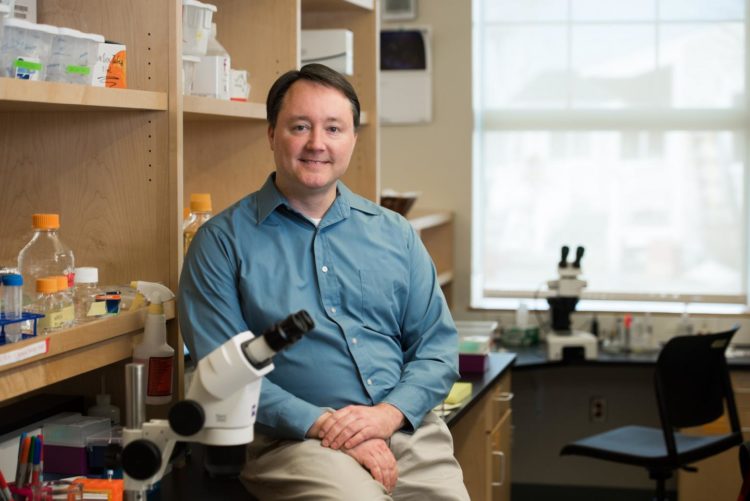Discoveries could one day lead to new drugs to prolong healthy human lifespan

Credit: MDI Biological Laboratory
BAR HARBOR, MAINE — The discovery in the 1990s that a mutation in a single gene of an experimental worm could double its lifespan set off a stampede of research on the molecular biology of aging and triggered hopes that drug therapies or other interventions could be developed to extend healthy human lifespan. But as is often the case in science, the genetic regulation of aging is more complicated than it first appeared.
The nature of this complexity is illuminated in a new paper by MDI Biological Laboratory scientists Jarod Rollins, Ph.D., and Aric Rogers, Ph.D., co-corresponding authors, which describes the mechanisms by which longevity is regulated post-transcriptionally, or after a genetic blueprint has been transcribed from an organism’s DNA. The identification of these mechanisms will serve as a road map for screening new, more specific drugs to prolong healthy lifespan.
The research was conducted in C. elegans, a tiny nematode worm that is a popular model in aging research because of its genetic similarity to humans and because of its short lifespan, which allows scientists to easily study lifespan-extending interventions.
“The MDI Biological Laboratory is deeply committed to translational research, or research that can be translated into therapies to improve human health in our focus areas of regeneration and aging,” said Hermann Haller, M.D., president. “Because it identifies new potential drug targets in the form of the post-transcriptional mechanisms governing longevity, this research will be hugely important in screening for new therapies to extend healthy human lifespan.”
The paper, “Dietary Restriction Induces Post-transcriptional Regulation of Longevity Genes,” which was recently published in the journal Life Science Alliance, is the product of five years of research in the Rollins and Rogers laboratories at the MDI Biological Laboratory.
The scientists used bioinformatics, or data analysis, techniques to compare genes in worms fed normal diets with those whose diets were restricted. Dietary restriction, or DR, which refers to calorie restriction without malnutrition, is the most robust intervention known for extending lifespan, and has been demonstrated to increase lifespan and delay the onset of age-related degenerative disease in a wide range of species, from one-celled yeasts to primates.
The scientific evidence on the lifespan-prolonging effects of DR has ignited a quest to develop “DR mimetics,” or drugs that mimic the effects of DR without the need to dramatically reduce calories. In addition to being difficult to adhere to, such a diet is associated with negative side effects including increased sensitivity to cold and loss of energy and libido. The identification of these new mechanisms opens up the possibility of developing new, more precise DR mimetics.
“Science already knows a lot about how longevity is regulated at the genetic level, but the picture isn’t complete if we just look at transcription,” Rollins said. “With this research, we are drilling down to additional layers of regulation, which brings us one step closer to extending healthy human lifespan without the need to dramatically restrict calories or to take drugs that, because they are less selectively targeted, are more likely to cause adverse reactions.”
The goal of DR mimetics is to access the adaptive programs in the cell that are activated when an organism is exposed to an existential threat such as a scarcity of nutrients. In such a case, the cellular machinery shifts from an emphasis on growth and reproduction, which is costly in terms of cellular resources, to an emphasis on survival. In order to ensure that an organism survives to reproduce when conditions improve, nature seeks to ensure that its cells function at peak efficiency.
In addition to confirming existing theories about the adaptive response to DR, the paper highlights the importance of post-transcriptional regulation — or regulation that occurs after a gene has been “read” or “transcribed” from the DNA in the nucleus of the cell. The identification of the mechanisms that govern post-transcriptional levels of gene expression charts a pathway for screening, or testing, drugs that may have pro-longevity effects.
“We found that hundreds of genes are being regulated almost solely at the post-transcriptional level,” Rollins said. “These are genes that weren’t previously known to have a role in longevity. This level of regulation can be missed if scientists are looking at the transcriptional level alone. The identification of these mechanisms gives us a better idea of how DR works and opens up a whole new area of potential investigation for the aging biology community.”
###
The research was supported by grants from the National Institute on Aging of the National Institutes of Health (NIH) (R21AG056743) and by the Ellison Medical Foundation (AG-NS-1087-13), both to Rogers, and by an Institutional Development Award (IDeA) from the National Institute of General Medical Sciences of the National Institutes of Health (P20GM0103423 and P20GM104318). Some strains of C. elegans were provided by the Caenorhabditis Genetics Center (CGC), which is funded by the NIH Office of Research Infrastructure Programs (P40 OD010440).
About the MDI Biological Laboratory
We are pioneering new approaches to regenerative medicine focused on developing drugs that slow age-related degenerative diseases and activate our natural ability to heal. Our unique approach has identified potential therapies that could revolutionize the treatment of heart disease, muscular dystrophy and more. Through the Maine Center for Biomedical Innovation, we are preparing students for 21st century careers and equipping entrepreneurs with the knowledge, skills and resources needed to turn discoveries into applications that improve human health and well-being. For more information, please visit mdibl.org.
Media Contact
Stefanie Matteson
[email protected]
201-787-7427
Original Source
https:/





